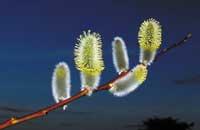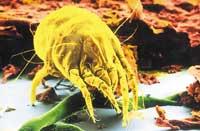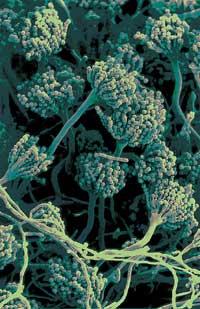Types of allergies

Some have curated grass fever, irritating the mucous membranes of the nose and eyes. Therefore, they have itching and fluidity, constantly dominating. Others get bronchial mucosa, which prevents them from breathing. Asthma symptoms are therefore a feeling of choking and coughing. Some also notice symptoms in the skin or subcutaneous layer.
Pollen houses male plant gametes measuring between 10 and 60 microns. Plants have different strategies to get to where female pollen gametes are. Some plants have scents and colors that attract insects; when the insect is placed in the plant, pollen sticks to the legs and when it goes to another flower the pollen expands. Plant pollen with this strategy are less dangerous for allergy sufferers. Other plants, however, have pollen suitable for air propagation, which cause serious problems to allergic people, especially pollen from grasses.
Allergy sufferers know perfectly when there is more pollen: when it does not rain long ago, when the temperature warms and when there is southern wind. Then there is a lot of pollen in the air and you should avoid breathing. To avoid symptoms, doctors recommend closing the windows well, putting on the glasses, not going out in high pollination hours, early in the morning and at sunset, if it is possible to walk by the sea and not on the mountain...

In addition to these basic measures, there are new methods to reduce inhaled pollen. For example, in Australia they tested a special filter to put it in the nostril and gave very good results. The filter is comfortable and does not prevent breathing. Pollen, on the other hand, is attached to a viscous layer of the filter, which allows to remove 97% of pollen from the breathing air. According to inventors, it is especially appropriate for people affected by antihistamines and other medications used to relieve symptoms.
Perhaps the most effective solution is specific vaccines. However, invention with immunotherapy is not always easy, as all allergens must be identified and treatment must be durable.
How is pollen concentration measured in the air?
To know the amount of pollen found in the air, instruments that catch pollen are used. These devices carry a fleece that guides the end of the pollen to the wind. In addition, they have a pump to absorb air at constant flow. The air enters through the end and the pollen are stuck on a tape covered with petroleum jelly. This tape is located on a rotating cylinder and once a week takes a full turn.
Every week the tape is changed. The received tape is cut, dyed and, with the help of the microscope, pollen are counted and identified.
It is not a flower but a domestic powder

The most widespread allergy in the Basque Country is that produced by domestic dust, specifically by dust mites. Mites are arthropods of 250-350 microns with a life cycle of 120 days. Maturity lasts 45 days, during which females lay 40 eggs. The most allergic are those of the genus Dermatophagoides, which are the so-called ‘skin jellies’. These mites feed on skin scales detached by humans and animals, very abundant in mattresses, bedrooms, carpets... Other species consume spores of fungi, seeds and cereal flours.
Temperate temperature zones and high humidity are ideal for the growth and reproduction of mites, so on the Basque coast they are abundant throughout the year, especially in spring and autumn. On the contrary, they are scarce in areas of more than 1,500 m and extreme temperatures. However, in the Spanish state, 65% of asthma cases are caused by mites. In fact, some mite glycoproteins are responsible for allergies. Due to their small size, they are easily breathable.
Unlike pollen allergies, those who tell mites have symptoms throughout the year. The most common symptoms are rhinoconjunctivitis and/or asthma, which are often more severe in adolescence and youth.

Among the measures to be taken by allergy sufferers are the absence of substances that emit dust in the home, the washing of bed linen with hot water, the decrease of humidity and the use of antimite substances.
From the impossible
“You have to eat everything,” he says many times. However, some people are allergic to certain foods. In children, most cases are due to eggs, milk, fish and nuts, and nuts, fresh fruits, fish and seafood in adults. In most cases, symptoms appear in the skin and mouth and in the digestive system, with less frequent symptoms typical of inhaled allergens, asthma and rhinoconjunctivitis.
Allergic reactions produced by food should be separated from food intolerance and toxic reactions. Intolerances and toxic reactions depend on the dose, while in allergies the reaction is always disproportionate, even when the ingested dose is very low. However, it is not easy to make a discriminatory diagnosis because the symptoms are similar.
When food awareness is extreme, there is a risk of anaphylaxis. It affects numerous organs and systems, with discomfort, abdominal and chest pain, nausea, diarrhea, arrhythmia, urticaria, hypotension and shock, and can cause death.

One variant is anaphylaxis caused by physical exercise. This is a very special case in which patients begin to play sports after eating some foods and as body temperature increases other symptoms of dizziness, itching and anaphylaxis appear. However, these symptoms do not appear if sports are not practiced. However, such cases are not very common.
Protein allergy of milk, fish, seafood, eggs, certain fruits and nuts is much more common. Sometimes, childhood allergy goes away over time. Some factors are known to influence this: taking the breast during the first few months protects the child, as well as the later than normal introduction into the diet of foods that can produce allergy.
To avoid allergy problems, it is recommended not to take these foods. This conditions the daily meals of allergy sufferers and forces them to carefully read the labels of packaged foods. In fact, milk proteins are used in many foods and also in some medications.
On the other hand, additives, preservatives and dyes that contain food can cause allergic reactions such as tartracins, sulfites, nitrites, glutamates, etc.
Allergy to work

No joke. More and more people are suffering from allergy for their work. In fact, some substances typical of various activities cause allergic reactions: latex, nickel, chromium, cobalt, resins, cements, cereals, plastics, cosmetics...
If the allergy is due to inhaled substances, asthma is the main symptom. On the contrary, if the allergic reaction occurs by contact with allergens, the symptoms appear on the skin: dermatitis and eczema.
If there is no way to avoid workplace allergens, there is no alternative but to change jobs, as there is no effective treatment.
It is clear that allergies are a serious problem that totally conditions the life of the patient. There are many studies on allergies, but more and more cases of sensitization and the proliferation of allergens. So it won't be easy to find a suitable solution for everyone. There is no choice but to try to anticipate it.

The most allergenic fungi come from the genera Alternaria, Aspergillus, Penicillium and Cladosporium.
Fungi reproduce by spores that measure between 1 and 100 microns. By inhalation, allergy sufferers usually have rhinitis and/or asthma, and some have skin symptoms. Humidity and darkness are beneficial for fungi, so allergies caused by fungi are usually more severe in autumn, but there is risk throughout the year depending on the place: in basements, where there is wet soil and plants... To avoid symptoms, it is best to avoid suitable conditions for fungi.

Some animals' hairs and thyme, as well as their saliva, urine, or feces, can also produce allergy. These allergens cause rhinitis, conjunctivitis, asthma, or hives in case of inhalation or contact with them.
The main enemy of many animal allergies is the cat, as some of its proteins in saliva are very allergenic. The enemies of others are not cats, but insects. 1% of the population is allergic to bee and wasp poisons and if these insects mature they are at risk of severe anaphylactic reaction and death as a result. There are also more allergenic insects such as mosquitoes, ants and bedbugs. Parasites also cause allergies.





